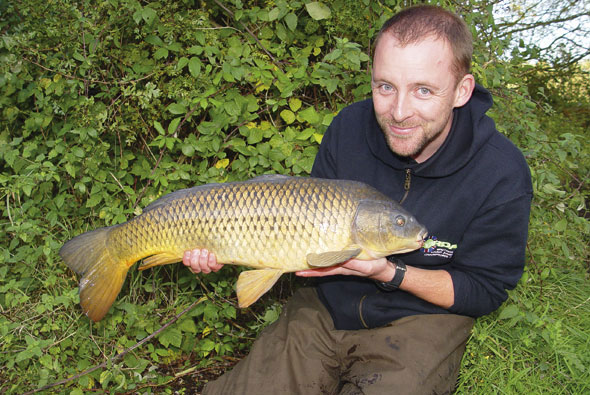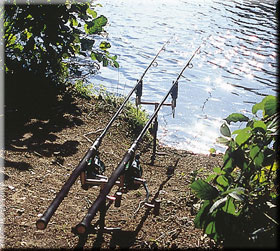How to catch carp in snaggy waters
Regardless of the water you fish, somewhere there will be a snag. An island, an overhanging or fallen tree, lily beds or tree stumps are always places which carp will be found in and around. Snags offer carp a feeling of safety and sanctuary and this is why they love them. These areas also offer a running buffet of natural food.
Snags are teeming with creatures such as water snails, caddis larvae and freshwater shrimps – all the things that a carp will happily crunch on for hours.
Where to fish
How do you locate where the snag starts and ends, once you’ve found one? The first stage is to cast leger with no hooklink using the lightest weight you can for minimum disturbance, then by gently pulling the rod back you will feel where the lead hooks up and where there are clear spots. To inch closer to the snag, let a little line off the reel and then clip up. Retrieve the line and cast again. You’ll be able to get closer and closer to the snag by repeating this process without casting into it.
This ‘leading around’, as it’s known, will help to give a mental image of where the snag starts and ends. The lead shouldn’t jam, as there is no hooklength attached. Use a safety clip so that if the lead does lock up, the clip will eject it, allowing you to easily retrieve your main line.
Once the snag’s make-up has been established and a clear spot found, you could cast a marker float to the area in order to find the depth. As long as it’s not too shallow, fish will generally be in the area because of the snag.
Hitting the same spot
Having established where to fish, add the hooklength. Keeping the line clipped up when casting will ensure that you hit the same spot every time. Carefully tighten down to the lead, making sure not to move it and take the mainline out of the clip.
In order to hit the exact same spot again after a run, Damian uses a line marker.
After tying a small length of light pole elastic on to the mainline, he slides the elastic till it lines up with the third ring of his rod.
After a run, cast away from the swim and wind back until the knot sits beneath the third rod ring. Place the line in the clip and then cast back into the
area that you’re fishing. This ensures that the rig hits the same spot every time. If fishing really close to a snag at night, pull the line marker back by one ring. The rig will be a good foot off the snag giving a margin of error.
A. Place the rod’s butt ring very close to or against the bite alarm.
B. Set your bobbins high to prevent too much line being released on a run.
C. Use the rod’s line clip to help keep everything taut.
D. You shouldn’t use any free-spool facility possessed by the reel. Fish ‘locked up’ and tighten the clutch fully. Braid is a better reel line than mono.
E. A tight butt grip is essential.
1 BANKSTICKS
Both banksticks have stabilisers fitted. This stops the bankstick from twisting in the ground. Make sure all thumbscrews are also tight.
2 BUTT GRIPS
Good butt grips are essential. Whichever make you use, they must firmly hold the rod’s handle. If the rod tip is pointing down or you’re fishing at a slight angle, the fish can pull the rod so hard they can pull the rod out of the clip. You could end up losing the rod or give the fish enough line to reach the snag. Either is a disaster!
3 REEL
Don’t engage the free-spool mechanism on the reel. Fish with everything ‘locked up’ and the clutch tightly set. The carp will not be able to take line and so won’t be able to get deeply into the snag.
ROD
Any carp rod will do for snag fishing. The rod set-up and the use of balanced tackle are much more important than a powerful rod.
5 LINE CLIP
These help to keep the line taut and give better bite indication.
BOBBINS
Set high in order to take as much stretch out of the mainline as possible. Add-on weights amplify this effect.
7 BUTT RING
Place the rod’s butt ring against the bite alarm for added stability and to help with the locked-up effect.
8 MAINLINE
Monofilament will stretch allowing the fish some room for movement. This stretch increases with distance. Consider using braided line, as braid has zero stretch.
Keeping the line down
DAMIAN’S terminal tackle starts with 18 inches of rig tube. This he colours in slightly with an indelible black marker. The black marker helps to camouflage the rig tube on the lake bed.
“It was just one of the many things that we learnt from some underwater video shoots,” says Damian. A small lump of lead putty is moulded around the top of the tube with a few twists of lead wire wrapped around the centre of the tubing. This helps to keep the rig tubing pinned down as air can become trapped in tubing, allowing it to lift slightly. This will spook any cruising fish, as the presentation looks very unnatural. A flying backlead is also used on the main line above the tubing. Flying backleads are small in-line leads that fly up the mainline on casting. This also helps to keep the main line pinned down to the lake bed and is a definite bonus when using braid as a main line.
Lead choice
A KORDA Grippa is Damian’s first choice of lead. These leads feature small lumps on both sides. The lumps offer more resistance for a better ‘bolt’ effect and are useful when presenting rigs on a slope or island shelf. The lead is fished with a Korda safety clip. These are imperative for fish safety, especially when fishing into a snag as the lead can be ejected if caught up.
Tail rubber sense
KORDA’S safety clips and tail rubbers have been designed to complement each other.
“A lot of anglers cut back the tail of the clip to allow easier ejection of a snagged lead. This is wrong as our safety clips were never meant to be used like this,” says Damian. Fishing with the tail rubber only a third of the way onto the clip will allow the lead to free itself easier.
An added advantage of the clip throwing the lead is that the carp will come up in the water rather than staying deep. This makes playing the fish much easier.
Feathering a cast
When casting a PVA bag attached to the hook, you need to slow the cast down just before the bag hits the water. This is known as ‘feathering’. Placing your finger lightly on the spool will slow the pace of the line, straightening out the rig or stopping the force of the bag, ejecting the lead as it hits the water.













